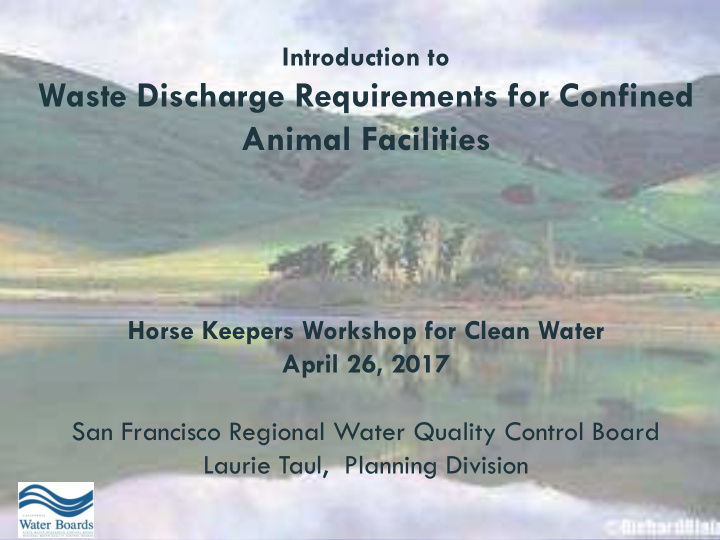



Introduction to Waste Discharge Requirements for Confined Animal Facilities Horse Keepers Workshop for Clean Water April 26, 2017 San Francisco Regional Water Quality Control Board Laurie Taul, Planning Division
Your Water Board San Francisco Bay Regional Water Quality Control Board 2 State agency responsible for protecting water quality and beneficial uses of water for the use and enjoyment of its people in the Bay Area Authorities come from: The federal Clean Water Act California’s Porter-Cologne Water Quality Control Act Water Quality Control Plan (Basin Plan) for the San Francisco Bay Basin
Impaired Water Bodies and TMDLs 3 Waters not meeting standards are designated as “impaired” Impaired water bodies trigger a process to evaluate sources of pollutants contributing to impairment Total Maximum Daily Load (TMDL) Plan to address water quality impairment Goal – attain or maintain water quality standards
Tomales Bay Watershed TMDLs completed : Pathogens Sediment Mercury Pathogen Sources: Septic systems Boat discharges Grazing Dairies Equestrian facilities Municipal runoff Small wastewater treatment facilities
TMDLs that identify CAFs Impaired Waters with TMDLs Sources of Bacteria and Sediment • Dairies Tomales Bay • Horse facilities • Dairies Sonoma Creek • Confined animal facilities Napa River • Horse facilities San Pedro Creek and Pacifica State Beach • Horse facilities San Vicente Creek (WQ Improvement Plan) 5
Current Programs for Animal Sources 6 Conditional Waiver of WDRs for Grazing Tomales Bay, Napa River and Sonoma Creek watersheds Conditional Waiver of WDRs for Dairies Renewed in June 2015 for 5-year term Applies only to dairies that certify compliance with statewide minimum standards General WDRs for Confined Animal Facilities Renewed in June 2016 Region-wide - Apply to all types of CAFs (dairy & non- dairy)
State CAF Regulations CAF defined as “ … any place where cattle, calves, sheep, swine, horses, mules, goats, fowl, or other domestic animals are corralled, penned, tethered, or otherwise enclosed or held and where feeding is by means other than grazing .” Title 27 State Minimum Standards CCR
State CAF Regulations and Permit Requires 8 Divert clean storm water away from areas with animals and/or manure Contain manure/bedding & storm water contacting it Apply solid/liquid wastes at appropriate rates for soil & crops with no discharge Manure/bedding must not be stockpiled or applied within 100 ft. of surface waters unless alternative practice is used.
State CAF Regulations and Permit Requires 9 Keep animals out of creeks within confined areas Contain non-storm water and other wastes Manage grazing lands to reduce bacteria and sediment runoff
2016 General Permit 10 Tier 1 CAFs that do not utilize liquid waste retention ponds. Applied to TMDL watersheds Tier 2 Dairies and others that utilize liquid waste ponds Future dairies and existing dairies after Waiver expires Tier 3 Any type of CAF that can not certify compliance or designated by Water Board due to its complexity, threat to water quality, or is contributing to adverse water quality impacts.
Tier 1 Requirements 11 Enroll by submitting Notice of 2016 Intent with fee 2017 Complete Monitoring and Sampling Plan Complete Ranch Water Quality 2018 Plan Schedule for improvements Request compliance extension if needed Submit completed Annual Report Annually form with sampling results
Water Quality Monitoring 12 Surface water sampling 3 storm events annually Measure of “residual dry matter” for grazing lands over 50 acres Visual inspections with photos Option for individual or watershed sampling program Option for reduced sampling after 2 years of good results
Sampling Procedures 13 When? During or directly following each of 3 major storm events, after at least 1 inch of rain per 24 hours. Sampling events shall be at least 14 days apart. Where? Upstream and downstream boundaries Near high-use and high-risk areas How? Clean container / representative sample Tests strip kits and water quality probe Each sample tested for all parameters immediately
Sampling Results Constituent Benchmark Sample I.D. Result Specific Below 2000 conductance µS/cm Below 1 ppm (or mg/l) and Total ammonia meets nitrogen (NH 3 + calculated NH 4+ ) unionized ammonia benchmark Unionized ammonia 0.025 mg/l (NH 3 ) as calculated pH 6.5-8.5 Temperature ( ° C) none 14
Visual Inspections 15 Everyone: Pre-rainy season preparations and photos Animal housing, corrals, manure storage areas, wash racks, etc. – daily Before, during and after storm events Document problems and corrective actions
Visual Inspections 16 If grazing 50 acres or more: Monthly during rainy season Twice during dry season RDM measurement in Fall If manure or compost is applied to land: Each day of application Record dates, location, volumes
Ranch Water Quality Plan 17 Lays out how your ranch meets the permit requirements and protects water quality Plan includes: Facility Map and Evaluation Implementation plan for improvements if needed, with description of temporary measures Description of pollution prevention practices for: Confined areas Waste storage Grazing and land management Land application
Summary 18 Site-specific requirements Improvements completed by November 2018 or request an extension After plan in in place, ongoing tasks include: Implement management practices Winter prep and sampling Visual inspections Annual reporting
Questions? Ag Program webpages: http://www.waterboards.ca.gov/sanfranciscobay/water_issues/ programs/TMDLs/agriculture/index.shtml Staff Contacts: Laurie Taul: Laurie.Taul@waterboards.ca.gov 510-622-2508 Jim Ponton: Jim.Ponton@waterboards.ca.gov 510-622-2492
Extra Slides 20
Sonoma Creek Watershed TMDLs completed : Pathogens Sediment Pathogen Sources: Septic systems Grazing Dairies Municipal runoff Municipal wastewater
The Napa River Watershed TMDLs completed : Pathogens Sediment Pathogen Sources: Septic systems Grazing Confined Animal Facilities Municipal runoff Municipal wastewater
San Pedro Creek and Pacifica State Beach Watershed TMDL : Bacteria Bacteria Sources: Sanitary sewer systems Horse facilities Municipal stormwater runoff and dry weather flows 23
San Vicente Creek Watershed Listing : Bacteria Priority Bacteria Sources: Horse waste Dog waste Municipal stormwater runoff Septic systems 24
Recommend
More recommend